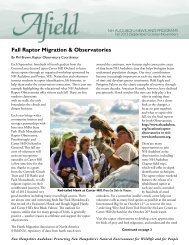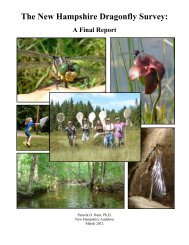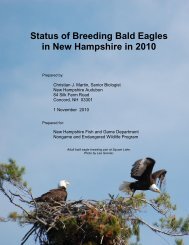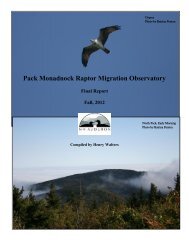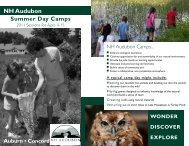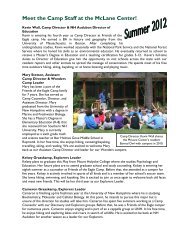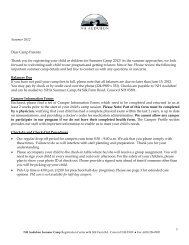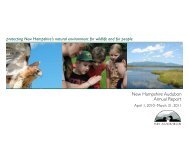Carter Hill Raptor Observatory - New Hampshire Audubon
Carter Hill Raptor Observatory - New Hampshire Audubon
Carter Hill Raptor Observatory - New Hampshire Audubon
Create successful ePaper yourself
Turn your PDF publications into a flip-book with our unique Google optimized e-Paper software.
History & Mission<br />
The <strong>Carter</strong> <strong>Hill</strong> <strong>Raptor</strong> <strong>Observatory</strong> was founded by <strong>New</strong> <strong>Hampshire</strong> <strong>Audubon</strong> (NHA) in 2008<br />
after being discovered as a good place to watch migrating hawks by local birders, Bob Quinn, Joe<br />
Quinn, and Rob Woodward the previous fall. A follow-up visit by NHA staff sparked interest in<br />
establishing a hawk watch at this location because of its impressive views from an observation<br />
platform, combined with its proximity to NHA‟s Concord headquarters and the high potential for<br />
outreach to the public. <strong>Carter</strong> <strong>Hill</strong> Orchard owner, Rob Larocque, willingly agreed with the request, and<br />
the partnership between NHA and the Orchard, a pick-your-own location in Concord, NH was founded.<br />
Since the fall of 2008, tens of thousands of visitors have spent time at the raptor observation platform<br />
and have had the chance to interact with NHA staff and volunteers and learn about raptor migration.<br />
NHA‟s stated mission is to protect <strong>New</strong> <strong>Hampshire</strong>‟s natural environment for wildlife and<br />
people, and it fulfills this role at the <strong>Observatory</strong> through both raptor migration research and<br />
educational outreach. <strong>Raptor</strong> and weather data that are taken by volunteers and staff are entered on<br />
HawkCount.org, an international hawk migration database run by the Hawk Migration Association of<br />
North America (HMANA), where it contributes to a larger understanding of raptor migration.<br />
Education is presented informally each day, with volunteers doing the bulk of the outreach. Staff<br />
programs and periodic special events are another component of the educational project.<br />
The autumn view to the north from the <strong>Carter</strong> <strong>Hill</strong> <strong>Raptor</strong> <strong>Observatory</strong> platform. Photo by Tom Brewton



